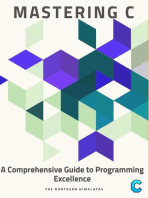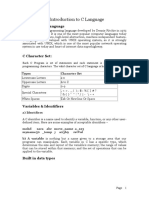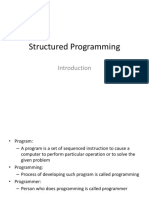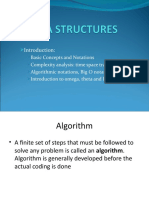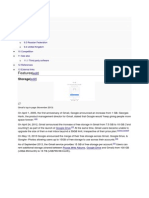Programming Language
Uploaded by
kj201992Programming Language
Uploaded by
kj201992Programming language
From Wikipedia, the free encyclopedia
An example of source code written in the Java programming language, which will print the message "Hello World!" to thestandard output when it is compiled and executed A programming language is a formal language designed to communicate instructions to a machine, particularly acomputer. Programming languages can be used to create programs that control the behavior of a machine and/or to express algorithms precisely. The earliest programming languages preceded the invention of the computer, and were used to direct the behavior of machines such as Jacquard looms and player pianos.[1] Thousands of different programming languages have been created, mainly in the computer field, and still many are being created every year. Many programming languages require computation to be specified in an imperative form (i.e., as a sequence of operations to perform), while other languages utilize other forms of program specification such as the declarative form (i.e., the desired result is specified, not how to achieve it). The description of a programming language is usually split into the two components of syntax (form) and semantics(meaning). Some languages are defined by a specification document (for example, the C programming language is specified by an ISO Standard), while other languages, such as Perl 5 and earlier, have a dominant implementation that is used as a reference.
You might also like
- Mastering C: A Comprehensive Guide to Programming ExcellenceFrom EverandMastering C: A Comprehensive Guide to Programming ExcellenceNo ratings yet
- Constants, Variables, & Data Types: Prepared By:vipul VekariyaNo ratings yetConstants, Variables, & Data Types: Prepared By:vipul Vekariya46 pages
- 60 TOP C LANGUAGE Multiple Choice Questions and Answers PDF 2017 Download100% (2)60 TOP C LANGUAGE Multiple Choice Questions and Answers PDF 2017 Download41 pages
- Esc - 1991 - Vol2 - Page710 - Ward - Manipulating Hardware With CNo ratings yetEsc - 1991 - Vol2 - Page710 - Ward - Manipulating Hardware With C6 pages
- Reverse String C Program Without Using StrrevNo ratings yetReverse String C Program Without Using Strrev24 pages
- Introduction To Java Programming (For Novices & First-Time Programmers)No ratings yetIntroduction To Java Programming (For Novices & First-Time Programmers)14 pages
- 10marks: 1.what Are The Various Data Types in C?Explain100% (1)10marks: 1.what Are The Various Data Types in C?Explain4 pages
- Conditional Statements in C ProgrammingNo ratings yetConditional Statements in C Programming11 pages
- Object Oriented Programming: Exception Handling in JavaNo ratings yetObject Oriented Programming: Exception Handling in Java21 pages
- List of Practicals - CSHP101 S/W Lab Based On CSHT 101 Programming Fundamentals - C++No ratings yetList of Practicals - CSHP101 S/W Lab Based On CSHT 101 Programming Fundamentals - C++4 pages
- C++ Programming: From Problem Analysis To Program Design,: Fourth EditionNo ratings yetC++ Programming: From Problem Analysis To Program Design,: Fourth Edition71 pages
- Why Learn C Programming Language - C Tutorial in Hindi #1 - Code With HarryNo ratings yetWhy Learn C Programming Language - C Tutorial in Hindi #1 - Code With Harry3 pages
- Mastering C: A Comprehensive Guide to Proficiency in The C Programming LanguageFrom EverandMastering C: A Comprehensive Guide to Proficiency in The C Programming LanguageNo ratings yet
- King (Website) : From Wikipedia, The Free EncyclopediaNo ratings yetKing (Website) : From Wikipedia, The Free Encyclopedia2 pages
- Controversy: Avoid, He Was Informed That King Approached Them To "Clone The Game Very Quickly"No ratings yetControversy: Avoid, He Was Informed That King Approached Them To "Clone The Game Very Quickly"1 page
- Match-Three Puzzle Video Game King Facebook Smartphones: Farmville 2 Daily MailNo ratings yetMatch-Three Puzzle Video Game King Facebook Smartphones: Farmville 2 Daily Mail1 page
- Gameplay: Adding Citations To Reliable SourcesNo ratings yetGameplay: Adding Citations To Reliable Sources1 page
- Lalalalalalalalalalalalalalallalallalalalal Bhvas QxsNo ratings yetLalalalalalalalalalalalalalallalallalalalal Bhvas Qxs1 page
- Advertising Email Google Secure Webmail Pop3 Imap4 Beta ReleaseNo ratings yetAdvertising Email Google Secure Webmail Pop3 Imap4 Beta Release1 page
- Communication: This Article Needs Additional Citations For Verification. Please Help by - Unsourced Material May Be andNo ratings yetCommunication: This Article Needs Additional Citations For Verification. Please Help by - Unsourced Material May Be and1 page
- Homework: Main Objectives and Reasons For HomeworkNo ratings yetHomework: Main Objectives and Reasons For Homework1 page
- Universal Solutions: Subject: Delhi-Jaisalmer-Jodhpur-Delhi Educational TourNo ratings yetUniversal Solutions: Subject: Delhi-Jaisalmer-Jodhpur-Delhi Educational Tour1 page
- Drama Film Madhur Bhandarkar Ajay Monga Anuraadha Tewari Mumbai Chandigarh Salim-SulaimanNo ratings yetDrama Film Madhur Bhandarkar Ajay Monga Anuraadha Tewari Mumbai Chandigarh Salim-Sulaiman1 page
- Bhim Rao Ambedkar College: To Whom It May ConcernNo ratings yetBhim Rao Ambedkar College: To Whom It May Concern1 page



